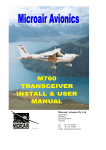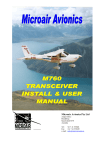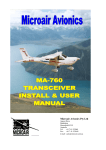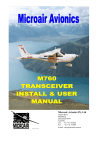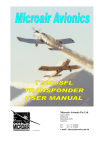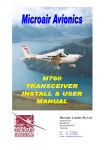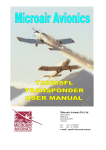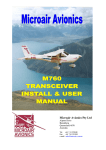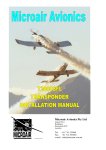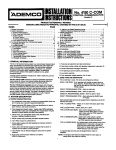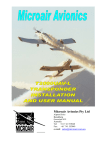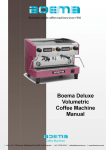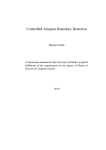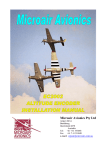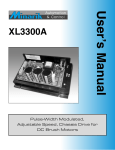Download Microair M760 transceiver installation and user manual
Transcript
Microair Avionics Pty Ltd Airport Drive Bundaberg Queensland 4670 Australia Tel: +61 7 41 553048 Fax: +61 7 41 553049 e-mail: [email protected] Microair Avionics M760 Transceiver Installation & User Manual About This Document This manual describes the various installation configurations available for the Microair M760 Transceiver. The Transceiver’s controls and design features are described and illustrated. Microair reserves the right to amend this manual as required, to reflect any enhancements or upgrades to the M760 Transceiver. © Microair Avionics Pty Ltd Ensure that the M760 transceiver is switched off during engine starting and stopping to avoid damage occurring. CURRENT REVISION STATUS Revision K L M N P 01R3 01R4 01R5 01R6 01R7 01R8 01R9 Date 31/01/00 18/11/01 04/10/02 08/12/03 01/10/06 13/10/06 30/05/07 28/06/07 3/06/08 08/12/08 25/2/09 24/4/09 M760-P Install & User Manual 01R9.doc Change Initial release Additional install data and wiring diagram added Additional wiring diagram added Updated for revision N Updated for revision P Updated for proposed functionality of revision P Proposed functionality for revision P amended Updated for functionality as of M760_MICRO_1-3-3 Warranty Statement Upgrade Updated for revision P2 Updated Limited Warranty Statement & deleted Warranty cards [email protected] added to Warranty Statement Page 2 of 28 24th April, 2009 Microair Avionics M760 Transceiver Installation & User Manual TABLE OF CONTENTS 1.0 2.0 INTRODUCTION.....................................................................................................................4 UNPACKING ............................................................................................................................4 2.1 2.2 USER / INSTALL MANUAL ........................................................................................................................4 AUTHORISED RELEASE CERTIFICATE...................................................................................................4 3.0 4.0 DESCRIPTION .........................................................................................................................5 INSTALLATION ......................................................................................................................6 4.1 4.2 4.3 ELECTRICAL INSTALLATION...................................................................................................................7 COAX TERMINATION.................................................................................................................................8 ANTENNA .....................................................................................................................................................8 4.3.1 4.3.2 4.4 METAL SKIN AIRFRAMES .................................................................................................................................................................... 8 NON-METAL SKIN AIRFRAMES .......................................................................................................................................................... 8 POWER...........................................................................................................................................................9 4.4.1 BACKLIGHTING ...................................................................................................................................................................................... 9 4.4.2 POWER SAVINGS .................................................................................................................................................................................... 9 4.4.3 4.5 4.5.1 4.5.2 4.6 4.7 4.8 POWER FILTER ........................................................................................................................................................................................ 9 MICROPHONE ............................................................................................................................................10 ELECTRET............................................................................................................................................................................................... 10 DYNAMIC ............................................................................................................................................................................................... 10 SPEAKER.....................................................................................................................................................10 INTERNAL VOX INTERCOM....................................................................................................................11 HEADSET ADJUSTMENT..........................................................................................................................11 4.8.1 SIDETONE ............................................................................................................................................................................................... 11 4.8.2 MIC GAIN ................................................................................................................................................................................................ 11 4.8.3 TRIMPOT ADJUSTMENT...................................................................................................................................................................... 11 4.9 4.10 EXTERNAL INTERCOM ............................................................................................................................12 DUAL COMM INSTALLATION ................................................................................................................12 5.0 OPERATIONAL CONTROLS..............................................................................................13 5.1 5.2 5.3 5.4 5.5 5.6 5.7 5.8 PRIORITY SWITCH ....................................................................................................................................14 VOLUME / SQUELCH KNOB ....................................................................................................................14 ANNUNCIATOR LED.................................................................................................................................14 MODE SWITCH...........................................................................................................................................15 FREQUENCY ADJUST KNOB...................................................................................................................15 TOGGLE SWITCH.......................................................................................................................................16 REMOTE MEMORY BUTTON ..................................................................................................................16 PUSH TO TALK BUTTON..........................................................................................................................16 6.0 MODES ....................................................................................................................................17 6.1 ACTIVE/STANDBY MODE........................................................................................................................17 6.1.1 6.1.2 108 TO 118 MHZ ..................................................................................................................................................................................... 17 MONITOR FUNCTION........................................................................................................................................................................... 18 6.2 6.3 CHANNEL MODE .......................................................................................................................................19 VOX MODE .................................................................................................................................................19 7.0 PROGRAMMING & SETUP ................................................................................................20 7.1 7.2 7.3 7.4 7.5 7.6 CD LOCKOUT .............................................................................................................................................20 VOX..............................................................................................................................................................21 MONITOR SETUP .......................................................................................................................................21 NEW MEMORY MODE ..............................................................................................................................22 EDIT MEMORY MODE ..............................................................................................................................22 EXIT MENU.................................................................................................................................................23 8.0 9.0 10.0 11.0 WIRING DIAGRAM..............................................................................................................24 SPECIFICATIONS M760 P2.................................................................................................25 DRILLING TEMPLATE .......................................................................................................26 LIMITED WARRANTY ........................................................................................................27 M760-P Install & User Manual 01R9.doc Page 3 of 28 24th April, 2009 Microair Avionics M760 Transceiver Installation & User Manual 1.0 INTRODUCTION Thank you for purchasing this Microair product. The M760 is a 760 channel VHF aircraft transceiver, packaged to fit a standard 57mm (2 ¼”) instrument hole. The M760 has been produced in accordance with CASA APMA approval E2000-004. 2.0 UNPACKING The M760 is boxed in polystyrene for physical protection, and wrapped in an anti-static bag for electrical protection. Once the box is opened and the radio unwrapped, the owner is responsible for physical and electrical protection. Enclosed with the radio are: User / Install Manual CASA form 1 – release certificate DB15 solder plug and backshell 2.1 USER / INSTALL MANUAL Please read this manual completely before attempting to install or operate this radio. There are several installation options you may wish to consider, which are clearly laid out in the installation section. The M760 has all of the basic radio operations, and many other management and programming options, which are described in the operation and memory sections of this manual. Please refer to the Microair Avionics Website www.microair.com.au for more installation information. 2.2 AUTHORISED RELEASE CERTIFICATE The CASA form 1 – release note is an internationally recognised document which clearly identifies the part/component the form 1 is associated with. Please keep this certificate with the aircraft’s file or log book. M760-P Install & User Manual 01R9.doc Page 4 of 28 24th April, 2009 Microair Avionics M760 Transceiver Installation & User Manual 3.0 DESCRIPTION The M760 VHF Transceiver has a 57mm (2 ¼”) round face to fit a standard small instrument hole. The case is 59mm high x 65mm wide x 135mm long. Front Face ITEM Rear Face CONTROL DESCRIPTION 1 M4 x 12 Pan Phillips Mounting screw 2 Priority Switch Momentary push down switch 3 Volume / On / Squelch Click On - Rotate knob for volume Rotate ring for squelch 4 Receiver / Transmit Annunciator Red / Green LED 5 Mode Switch Momentary push down switch 6 Frequency Adjust Knob Rotate to adjust value Press to move cursor 7 Toggle Switch Momentary push down switch 8 DB15 Connector Push in fit with lock nuts 9 BNC Coaxial Connector 10 LCD Display M760-P Install & User Manual 01R9.doc Two lines of eight characters each Page 5 of 28 24th April, 2009 Microair Avionics M760 Transceiver Installation & User Manual 4.0 INSTALLATION The M760 is very simple to physically install in an aircraft’s instrument panel. Select or cut a 57mm (2 ¼”) instrument hole for mounting. Present the M760 to the rear face of this hole. The stepped round face will insert through the hole, and should appear flush with the front of the instrument panel when correctly positioned. Rotate the M760 to align the four M4 machine screws. For installations where the existing instrument panel screw holes are 1/8”, the hole will need to be enlarged to 5/32” to fit the M4 machine screws. Insert and tighten all four M4 machine screws. The M760 requires no rear support, the M4 screws provide all of the physical mounting required. 50 OHM COAX BNC CONNECTOR WIRING HARNESS NO REAR SUPPORT REQUIRED DB-15 CONNECTOR MIC GAIN TRIM POT SIDETONE TRIM POT M4 MACHINE SCREWS 57MM (2 1/4") INSTRUMENT HOLE MICROAIR MA-760 PANEL INSTALLATION The M760 should be located in the aircraft within view of the pilot seated in the pilot-in-command position, and afford this pilot good access to the front face controls. Do NOT oversize the mounting holes in the front face of the radio, to an imperial size. Drilling will damage internal components. Do NOT replace the M4 machine screws supplied with the radio with longer screws. Over-length screws will touch or even crush internal components and cause damage. Either of these actions will void the warranty M760-P Install & User Manual 01R9.doc Page 6 of 28 24th April, 2009 Microair Avionics 4.1 M760 Transceiver Installation & User Manual ELECTRICAL INSTALLATION Microair recommends the use of the wiring in the table below for the various parts of the radio harness: Line Power Ground PTT Memory Signal Ground Speaker Microphone Headphone Aerial Wire Tefzel 22 awg wire (2 lines) Tefzel 22 awg wire (2 lines) Tefzel 22 awg wire Tefzel 22 awg wire Tefzel 22 awg wire Tefzel 22 awg single core shielded Tefzel 22 awg single core shielded Tefzel 22 awg single core shielded RG58C/U 50 ohm Coaxial Cable All wiring is connected by soldering to the DB15 connector. Strip the insulation back 2mm (1/16”), and “tin” the exposed conductor with solder. Slide a 5mm length of 3.2mm (1/16”) heatshrink tubing over the end of the wire. After checking the wiring diagram for the correct pin number, push the “tinned” end into the terminal, and solder into place. Check the soldered joint has been made, by gently pulling on the wire. Slide the heatshrink tubing down over the soldered pin, to completely cover the conductor. “Tinned” wire Soldered with heatshrink Locking bolts tightened Cover the soldered joints with the grey plastic backshells. Ensure that the locking bolts are in place before closing the backshells. Connect to the rear of the radio with a push fit, and secure the locking bolts (top and bottom). Microair recommends the use of its pre-wired M760 harness. The harness is available from Microair, and comes complete with all switches, sockets, buttons, and mounting hardware. Separate lines have been wired for Pilot and Co-pilot: • Headphone • Microphone • PTT • Remote Memory M760-P Install & User Manual 01R9.doc Page 7 of 28 24th April, 2009 Microair Avionics 4.2 M760 Transceiver Installation & User Manual COAX TERMINATION The coax is cut to length and terminated in a BNC connector. Soldered or crimp type connectors are preferred to the solderless variety, as they have lower signal loss and better shielding. Microair recommends using only soldered or crimped BNC connectors. Solderless BNC connectors are NOT recommended, as their performance is not good enough for VHF transmissions. 4.3 ANTENNA For certified aircraft the M760 should only be operated with a TSO compliant antenna. The antenna may be ¼ wave whip or ½ wave dipole, using 50ohm coaxial cable and a BNC connector for connection. The VSWR should ideally be less than 2:1 across the 118.000MHz to 136.975MHz airband. For non-certified aircraft using a non-TSO compliant antenna, the VSWR must be checked to ensure the ratio does NOT exceed 3:1 across the 118.000MHz to 136.975Mhz airband. The M760 will tolerate a VSWR of 5:1 without injury to the transceiver, but the performance is severely deteriorated. Do not use the stubbie “rubber duckie” antennas meant for use with handheld radios. 4.3.1 Metal Skin Airframes For metal skin aircraft a ¼ wave whip is the easiest antenna to fit. Ensure that the antenna base and the coax shield are firmly grounded to the skin of the airframe, on the inside of the aircraft. Ensure that any anti-corrosion product, which may be used to seal the exterior surface, does not isolate the antenna base from the airframe. For best performance the whip should be straight and vertical, when mounted on the airframe. Refer to the Microair Avionics website www.microair.com.au for more detail on antennas suitable for metal skin airframes. 4.3.2 Non-Metal Skin Airframes For non-metal airframes, a ¼ wave whip may still be used, but a ground plane must be installed, on the inside face of the aircraft skin. The ground plane should ideally be circular, and have a diameter of half the height of the whip. The ground plane should be fabricated from a lightweight metal, eg thin aluminium sheet, or adhesive foil tape. For best performance the ground plane should be flat and horizontal, when mounted on the airframe. An alternative antenna for non-metal airframes is the Ground Plane independent dipole. This antenna is physically similar to the ¼ wave whip, but has a small stubbie antenna pointing downwards from the antenna base. The stubbie section of the antenna takes the place of the ground plane, and simplifies installation. Beware of fabric surfaces with silver dope finishes. The silver dope is a conductive surface, and with screen antennas which are mounted internally. Refer to the Microair Avionics website www.microair.com.au for more detail on antennas suitable for non-metal skin airframes. M760-P Install & User Manual 01R9.doc Page 8 of 28 24th April, 2009 Microair Avionics 4.4 M760 Transceiver Installation & User Manual POWER The M760 is designed to operate on a 14V aircraft electrical supply. The radio will operate down to 10.7V on receive. It is unlikely that a power supply operating below 11V would have sufficient power to allow clear transmissions. The M760 will draw approx 1.6A when transmitting. Low power will produce a BURRRRRRRRRR signal. The maximum voltage for the M760 is 18V. NEVER operate the M760 on voltage exceeding 16V. Damage will occur if the M760 is operated from power supplies which exceed 16V, even for very short (transient) periods. Operation on a supply which exceeds 16V will void the warranty. The M760 has a diode and internal fuse to protect against reverse polarity. If reverse polarity is applied the fuse (4A) will blow. Damage however may not be limited to the fuse. Please ensure that the correct polarity is observed. The most common reason for reverse polarity, is misreading the pin assignments on the DB-15 connector. Applying reverse polarity to the M760 will void the warranty 4.4.1 Backlighting The backlighting is activated, by taking input supply voltage to pin 8. This line can be individually switched outside the DB15 connector to enable the backlighting to be turned off. The power for the backlighting may be routed from a dimmer switch. The power must however be ultimately sourced from the avionics master switch, to ensure that all components of the M760 are off during start-up and shutdown of the engine. 4.4.2 Power Savings For installations, operating from a battery only, Microair recommends saving battery power by NOT wiring the backlighting – do NOT wire pin 8. The backlighting will draw an additional 80mA of power. This nearly doubles the standby power demand. Not connecting the backlighting can effectively double the running time on your battery. The operator should remember that the minimum operating voltage is 10 volts. This is the loaded voltage (ie the voltage when the radio is transmitting). For battery operators, check the battery voltage level, then press the PTT briefly to note the voltage drop. If the voltage dips by more than 0.2 volts, change the battery before flying. 4.4.3 Power Filter Microair recommends the installation of a power filter to supply power to the M760. A simple line filter is sufficient to ensure that the voltage is smooth, and causes no interference to the radio. If an engine noise can be heard, and it rises and falls with the RPM, install a power filter. Refer to the Microair Avionics website www.microair.com.au for more information on aircraft electrical systems. M760-P Install & User Manual 01R9.doc Page 9 of 28 24th April, 2009 Microair Avionics 4.5 M760 Transceiver Installation & User Manual MICROPHONE The M760 can be operated with an Electret Insert or Amplified Dynamic microphone. These alternatives cover most aviation headsets and hand microphones. When the PTT is pressed both microphones are live. To reduce background noise, the M760 can be installed with relays across the mic lines and the PTT line, to allow only one microphone at a time to operate. 4.5.1 Electret Electret microphones are the most common microphone in use on aviation headsets. They are small in size, and can have noise cancelling capability. It is important to wire the Electret microphone with the correct polarity. The Electret will only work if the positive and negative are wired correctly. Electrets are a high signal device, and do not normally require amplification. Some headset manufacturers elect to use an amplifier to improve the Electret’s response, and to provide some noise filtering. 4.5.2 Dynamic Dynamic microphones are a low signal device. A dynamic microphone will not operate directly with an M760 radio, because of the low signal produced. For operators wanting to use a dynamic microphone, a mic amplifier must be used. Microair recommends the installation of the Microair MD-01a amplifier. This amp is compatible with 150-600 ohm dynamic microphones. LINES TO DYNAMIC MIC OR MIC JACK CONNECTOR (MIC END) MIC SIGNAL LINE (7-9 VOLTS) MD-01a Refer to the Microair Avionics website www.microair.com.au for further details on microphone types, and wiring configurations. 4.6 CONNECTOR (RADIO END) CRIMP TERMINALS GROUND SPEAKER Microair recommends using a speaker of 4 ohms impedance, rated at a minimum of 5 watts. The speaker is wired to the speaker line (pin 15). Do NOT attempt to connect a speaker to the headphone line (pin 14). Likewise do NOT attempt to connect the headphones to the speaker line. Microair recommends the SP01 Box Speaker. The SP01 has a durable thick film plastic cone of 4 ohms, and is rated at 5 watts. The SP01 is fitted with a mounting bracket, and is supplied with clips and screws. Check your speaker choice by ensuring the audio is clear up to at full volume. M760-P Install & User Manual 01R9.doc Page 10 of 28 24th April, 2009 Microair Avionics 4.7 M760 Transceiver Installation & User Manual INTERNAL VOX INTERCOM The M760 is fitted with a VOX intercom feature which utilises the sidetone facility of the radio. The VOX threshold level is controlled in software by use of the Intercom Adjust Mode. See section 5.4 to adjust the internal VOX intercom. 4.8 HEADSET ADJUSTMENT It is important to ensure that the sidetone and mic gain are set to the correct levels, for best headset performance. The sidetone level will set the VOX intercom volume. The mic gain will set the level of microphone sensitivity for each headset. 4.8.1 Sidetone Adjust the sidetone if necessary for good volume level using the VOX intercom. Ensure that the headset volume adjust is set to mid range, so the volume came be adjusted up/down by the user. 4.8.2 Mic Gain Adjust the microphone gain if necessary for best audio “quality” not volume level. Use the VOX intercom operation to achieve best performance. The M760 P2 is fitted with separate mic gain trimpots to allow for adjustment of individual headsets. 4.8.3 Trimpot Adjustment Punch the black dot carefully with a screwdrive blade, to expose the slotted plastic head of the trimpot, located appox 3mm (1/8”) below the surface of the casing. The second mic gain position is not marked, refer to the drawing below for location. Note the position of the slot before making adjustments. Use a small flat bladed screwdrive to make small adjustments before testing with a headset again. The total movement of all trimpots is only 300 degrees (4/5th turn). Do not attempt to adjust the modulation or power output. These adjustments can only be set correctly by a qualified technician. Adjustment of the power output or modulation by anyone other than Microair or their approved agent will void the warranty. M760-P Install & User Manual 01R9.doc Page 11 of 28 24th April, 2009 Microair Avionics 4.9 M760 Transceiver Installation & User Manual EXTERNAL INTERCOM Where the M760 is to be installed with an external intercom, the internal VOX intercom should be disabled in the Program Mode Menu. See section 7.2. Wire only a single mic line (pin 1), along with the PTT (pin 7), the headphone (pin 14), and a ground line (pin 11 or 12) to the intercom. Follow the intercom manufacturer’s instructions for further installation. Wire the remote memory line (pin 13), directly to the remote memory button location. This line is NEVER connected to the external intercom. Refer to the Microair Avionics website www.microair.com.au for more details and wiring diagrams with commonly used intercoms. 4.10 DUAL COMM INSTALLATION Where two M760’s are to be installed in the aircraft, the interlock lines must be installed. Each interlock line shall be wired from (pin 4) on the first radio to (pin 7) on the second radio, and vice versa. The interlock line allows the second radio to sense when the first radio is transmitting. In this situation the other radio deactivates its receiver to prevent any chance of damage to the second radio, or allow distortion noise to occur. Refer to the Microair Avionics website www.microair.com.au for a full two comm wiring diagram. Microair recommends the use of a rotary selector or multi-pole switch to switch the microphone and PTT lines from the first radio to the second. This selector should be clearly labelled. M760-P Install & User Manual 01R9.doc Page 12 of 28 24th April, 2009 Microair Avionics M760 Transceiver Installation & User Manual 5.0 OPERATIONAL CONTROLS Front Face ITEM Control Column CONTROL DESCRIPTION 1 Priority Switch Momentary push down switch 2 Volume / On / Squelch Click On - Rotate knob for volume Rotate ring for squelch 3 Receiver / Transmit Annunciator Red / Green LED 4 Mode Switch Momentary push down switch 5 Frequency Adjust Knob Rotate to adjust value Press to move cursor 6 Toggle Switch Momentary push down switch 7 Remote Memory Button Momentary push button 8 Push to talk (PTT) Button Momentary push button M760-P Install & User Manual 01R9.doc Page 13 of 28 24th April, 2009 Microair Avionics 5.1 M760 Transceiver Installation & User Manual PRIORITY SWITCH The priority switch is a push down switch. When pushed down briefly, the radio will go into channel mode, and select the frequency stored in memory 99. Memory 99 should be considered the priority channel, which the user can quickly select when required. Memory 99 must be programmed for the priority switch to operate. Memory 99 is set at the factory as the international distress frequency 121.500MHz. Memory 99 can be programmed the same way as any of the other channels, hence the factory default can be edited. Refer to section 7.5 to edit this memory. The priority channel (memory 99) can not be deleted; it will default back to 121.500MHz – EMGY. 5.2 VOLUME / SQUELCH KNOB The M760 is turned on, by rotating the volume knob. A positive “click” is heard and felt at the start of the rotation to indicate the on/off position. The volume is increased by rotating the knob clockwise, and decreased by rotating counter clockwise. The squelch is adjusted by rotating the ring behind the volume knob. There is no automatic level set for the squelch, however the ring affords a large manual adjustment to suit all situations. Rotate the ring clockwise to increase the squelch threshold, and counter clockwise to lower the threshold. When the squelch is “broken” (ie the static hiss can be heard), the annunciator LED lights green. Note: 5.3 This does NOT mean you are receiving a signal! ANNUNCIATOR LED The LED operates red or green, and indicates the following states: Clear (off) Radio is squelched, and is not receiving a signal Green Squelch is broken or a signal is received Red Radio is transmitting Flashing Red Radio has transmitted for over 45 seconds (warning) The flashing red signal is designed to draw the pilot’s attention to the fact that the aircraft may have a stuck PTT button! Transmissions in excess of 30 seconds should be avoided. While the M760 is in the program mode menu or memory programming mode the M760 is in its setup state. The radio can not transmit or receive while it is in the setup state. M760-P Install & User Manual 01R9.doc Page 14 of 28 24th April, 2009 Microair Avionics 5.4 M760 Transceiver Installation & User Manual MODE SWITCH The mode switch is a push down switch, which will cycle through the operational modes of the M760. When pushed down briefly the radio will step to the next operating mode. ACTIVE / STANDBY MODE (Refer section 6.1) Press Mode Key CHANNEL MODE Press Mode Key (Refer section 6.2) Press Mode Key INTERCOM ADJUST (Refer section 6.3) If the internal VOX intercom has been disabled in the program mode menu the intercom adjust mode will be skipped. See section 7.2 to enable / disable the internal VOX intercom. 5.5 FREQUENCY ADJUST KNOB The frequency adjust knob is used to change display values and characters. Rotate the knob to scroll values or characters up or down. Press the frequency adjust knob inwards briefly to move the cursor to the next display item to adjust. In the active/standby mode, only the standby frequency can be changed directly, the active frequency cannot be directly altered by the frequency adjust knob. Cursor MHz KHz In channel mode the pilot can scroll alphabetically by turning the frequency adjust knob. Adjustment is restricted to the pre-programmed values stored in memory. Refer to section 7.5 for the input and amendment of channel memory database. Channel Frequency Channel Name In VOX mode the threshold level can be adjusted up or down by turning the frequency adjust knob. Adjustment is restricted to values between 1 and 30. Threshold Level M760-P Install & User Manual 01R9.doc Page 15 of 28 24th April, 2009 Microair Avionics 5.6 M760 Transceiver Installation & User Manual TOGGLE SWITCH When the toggle key is pressed briefly in Active/Standby mode, the active and standby frequencies exchange places. Hold the toggle key down for 3 seconds to activate the monitor function. • • When the M760 is in monitor mode, press the toggle key briefly to dis-engage the monitor function. When the M760 is in channel mode the toggle key is used to quick save the frequency. The toggle key is also used in the PROGRAM MODE for programming functions. 5.7 REMOTE MEMORY BUTTON If fitted at installation, the remote memory button will have the same functionality as the toggle button. It will allow the user to toggle (exchange) the active and standby frequencies. The remote memory button is typically mounted next to the PTT on the stick. If the remote memory button is held down for 3 seconds while in the active / standby mode, the monitor function is activated. Refer to section 6.1.2 for complete details on monitor function. In channel mode, press the remote memory key briefly to cycle through the stored memory channels. When the M760 is in VOX adjust mode, press the remote memory key briefly to increase the VOX threshold. IMPORTANT NOTE The remote memory button is highly recommended. It allows the user to be able to keep hands on the controls during flight, while changing channels or scanning. 5.8 PUSH TO TALK BUTTON The push to talk (PTT) button causes the M760 to transmit on the active frequency or selected memory channel. During transmission the LED annunciator will light red and the user will hear themselves speaking through their own headphones via the sidetone system. The M760 will not transmit if the active frequency or selected memory channel is below 118MHz. The M760 will not transmit if the CD lockout function is enabled and the M760 is currently receiving a signal. See section 6.1 to enable / disable the CD lockout function. M760-P Install & User Manual 01R9.doc Page 16 of 28 24th April, 2009 Microair Avionics M760 Transceiver Installation & User Manual 6.0 MODES The M760 transceiver can operate in several operation modes. The user can step through these modes by pressing the mode key briefly. Operational modes are: ¾ ¾ ¾ 6.1 Active/Standby Mode Channel Mode VOX Mode ACTIVE/STANDBY MODE The display shows the active or in use frequency on the top line. The standby frequency is displayed on the bottom line. Only signals on the active frequency are received. Transmissions can be made on the active frequency by pressing the PTT button. The active and standby frequencies are swapped by pressing the remote memory button or the toggle switch. The standby frequency can be changed by scrolling the frequency adjust knob. The cursor can be moved between MHZ and KHZ positions by pressing the frequency adjust knob. Press the mode key to toggle the display from Active/Standby mode to Memory mode. 6.1.1 108 to 118 MHz The pilot can select channels in the navigation (NAV) band from 108.000MHz to 117.975 MHz. The M760 will receive only on these channels – the PTT button is disabled. Many civil aviation authorities are now allocating voice services such as ATIS in the NAV band. M760-P Install & User Manual 01R9.doc Page 17 of 28 24th April, 2009 Microair Avionics 6.1.2 M760 Transceiver Installation & User Manual Monitor Function By holding down the remote memory button or toggle key for 3 seconds and then releasing, the M760 will enable the monitor function. Both active and standby frequencies are monitored at the same time for a signal. An ‘M’ character will oscillate up and down to indicate that the monitor function is active. A signal can be received on either the active or the standby frequency. While receiving a signal on the active frequency the standby channel is NOT monitored. While receiving a signal on the standby frequency the active channel is periodically monitored. If a signal is found on the active frequency the M760 will revert to the active frequency. After a signal has been received the M760 will return to monitoring both frequencies. IMPORTANT NOTE The user can only transmit on the active frequency. If the PTT is keyed the radio will transmit on the active frequency only. Monitor mode can be cancelled by pressing the remote memory button or toggle key briefly. The ‘M’ character is no longer displayed at the right hand end of the display. If the mode key is pressed to move to channel mode, the monitor function is dis-engaged. Monitor Mode Monitoring on ACTIVE frequency Monitor Mode Monitoring on STANDBY frequency Monitor Mode Receiving on ACTIVE frequency Monitor Mode Receiving on STANDBY frequency Monitor Mode Transmitting on ACTIVE frequency IMPORTANT NOTE When active and standby channels are within 100KHz (4 channels), some interference may be heard when receiving on both frequencies at the same time. The interference is most prominent where there is a significant difference in signal strength between standby and active. M760-P Install & User Manual 01R9.doc Page 18 of 28 24th April, 2009 Microair Avionics 6.2 M760 Transceiver Installation & User Manual CHANNEL MODE The M760 has memory database which can store up to 99 channels. Each channel can be programmed with any available frequency from 108.000 to 136.975MHz, and an 8 character channel name. Refer to the PROGRAM MODE Menu (sections 7.4 & 7.5) for details on the programming of memories. Channel Frequency Channel Name When operating in channel mode, the programmed channels can be scrolled through alphabetically, by rotating the frequency adjust knob, or by pressing the remote memory button. Only programmed memories are displayed. When changing operational modes the Active Frequency remains constant. When the operational mode is changed to channel mode the M760 will check all memory channels for the current active frequency. If it finds the current active frequency it will display the memory channel that corresponds to the current active frequency. If the current active frequency is not found in any memory channel a ‘?’ will be displayed on the bottom line. This active frequency can be quick saved in the next unused memory channel by pressing the toggle key. Any quick saved memory channels will appear at the end of the alphabetically sorted memory channels. Factory setup defaults the first 5 memory channels to CH 01 through CH 05 for test purposes. The pilot is free to edit these channels to desired channel name and frequency. 6.3 VOX MODE The M760 has a digitally controlled VOX intercom. The frequency adjust knob is used to adjust the VOX threshold. When the VOX is adjusted to one the mic’s will be on all of the time (hot mic). When the VOX is adjusted to 30 the mic’s will require a very loud voice to activate. When in VOX mode the active frequency is displayed on the top line. M760-P Install & User Manual 01R9.doc Page 19 of 28 24th April, 2009 Microair Avionics M760 Transceiver Installation & User Manual 7.0 PROGRAMMING & SETUP The M760 can be started in program mode by holding the mode key down and turning on. The mode must held down while the display goes through the start-up sequence, and end with PROGRAM MENU on the display. Rotate the frequency adjust knob to scroll through the Program Mode Menu items. Use the remote memory button or the toggle switch to select the menu item. PROGRAM MODE MENU MENU CD VOX MONITOR NEW MEM EDIT MEM EXIT 7.1 CD LOCKOUT When CD Lockout is set ON the M760 will not permit the PTT button to operate if a radio signal is currently being received. If the user attempts to transmit by keying the PTT, the M760 will not transmit. The signal being received will be heard in the headphones or speaker. When CD Lockout is set OFF the M760 will permit the PTT to operate if a radio signal is currently being received. Background: In high traffic areas such as circuit patterns, there is often a high level of radio traffic. There is also a high instance of two aircraft trying to transmit at the same time. When this occurs the two transmissions interfere with each other, and neither call can be properly received. The CD Lockout is toggled by pressing the Toggle Switch. The factory default is to have the CD lockout OFF. M760-P Install & User Manual 01R9.doc Page 20 of 28 24th April, 2009 Microair Avionics 7.2 M760 Transceiver Installation & User Manual VOX When VOX setup is set ON the M760 the user is able to set the threshold of the internal VOX intercom via the intercom adjust screen. (See section 6.3) When VOX setup is set OFF the M760 will set the internal VOX intercom to its maximum threshold and disable the Intercom Adjust screen. The VOX setup is toggled by pressing the Toggle Switch. The factory default is to have the internal VOX intercom ON. 7.3 MONITOR SETUP MONITOR setup allows the user to adjust the interval of the monitor function. Background: Although the M760 only contains one receiver, it can monitor two frequencies at the same time. This is done by checking each frequency for just long enough to determine if there is a signal present. If no signal is present on the first frequency it can switch to the second frequency and check for a signal in the same manner. When a signal is found the receiver is locked to that frequency. This is not a problem when the signal is received on the active frequency. However when a signal is received on the standby frequency the active frequency must still be monitored. This is achieved by periodically checking the active frequency for long enough to determine if there is a signal present. If no signal is found the receiver returns to the standby frequency. During the check of the active frequency the standby frequency is not being received, this can be perceived as a short click. The M760 allows the interval between successive checks of the active frequency to be set by the pilot. The MONITOR setup can be adjusted by pressing the Toggle Switch or the remote memory button. The adjustment is restricted to values between 1 and 9. The factory default is a interval of 5. M760-P Install & User Manual 01R9.doc Page 21 of 28 24th April, 2009 Microair Avionics 7.4 M760 Transceiver Installation & User Manual NEW MEMORY MODE This option allows the user to program a new channel in memory. The frequency and channel name for the new memory channel can be set in this mode. This option will automatically select the next unused memory channel and start the memory programming process. Using the frequency adjust knob set the frequency for the selected memory channel. The cursor can be cycled through the MHz and KHz by pressing the frequency adjust knob. Once the frequency is set press the remote memory button or the toggle switch briefly. Cycle cursor between MHz, and KHz, by pressing the frequency adjust knob inwards briefly. Rotate the frequency adjust knob to change value. Using the frequency adjust knob set the name for the selected memory channel. The cursor can be cycled through the character positions by pressing the frequency adjust knob. Once the name is set press the remote memory button or the toggle switch briefly. Cycle cursor between character positions, by pressing the frequency adjust knob inwards briefly. Rotate the frequency adjust knob to change the character. The word SAVED appears on the bottom line. The M760 will then return to the Program Mode Menu. 7.5 EDIT MEMORY MODE This option allows the user to program a channel in memory. The frequency and airport code stored in each memory channel can be set, changed, or cleared in this mode. Using the frequency adjust knob select the memory channel to program. If the currently selected memory channel exists in memory the frequency and name are displayed. If the currently selected memory channel does not exist, only the memory channel number will be displayed in the top left corner of the display. To create a new memory channel or edit an existing memory channel, scroll to the desired memory channel and press down the remote memory button or toggle switch briefly. M760-P Install & User Manual 01R9.doc Page 22 of 28 24th April, 2009 Microair Avionics M760 Transceiver Installation & User Manual Using the frequency adjust knob set the frequency for the selected memory channel. The cursor can be cycled through the MHz and KHz by pressing the frequency adjust knob. Once the frequency is set press the remote memory button or the toggle switch briefly. Cycle cursor between MHz, and KHz, by pressing the frequency adjust knob inwards briefly. Rotate the frequency adjust knob to change value. Using the frequency adjust knob set the name for the selected memory channel. The cursor can be cycled through the character positions by pressing the frequency adjust knob. Once the name is set press the remote memory button or the toggle switch briefly. The word SAVED appears on the bottom line. Cycle cursor between character positions, by pressing the frequency adjust knob inwards briefly. Rotate the frequency adjust knob to change the character. The word SAVED appears on the bottom line. The M760 will then return to the Program Mode Menu. To clear a memory, scroll to the desired memory channel and press down the priority switch briefly. The word CLEARED appears on the bottom line. To return to the Program Mode Menu, press down the mode switch briefly. Operating the priority switch in either Active/Standby mode, Channel mode, or VOX mode will move the M760 to memory 99. The user should consider carefully what frequency to program in memory 99. The factory default is the distress frequency 121.500MHz. 7.6 EXIT MENU This option exits the program mode menu and causes the radio to sort the memory channels and step into Active/Standby Mode. M760-P Install & User Manual 01R9.doc Page 23 of 28 24th April, 2009 Microair Avionics M760 Transceiver Installation & User Manual 8.0 WIRING DIAGRAM M760-P Install & User Manual 01R9.doc Page 24 of 28 24th April, 2009 Microair Avionic M760 Transceiver Installation & User Manual 9.0 SPECIFICATIONS M760P2 Radio Type Amplitude Modulation (AM) Aircraft Transceiver Channels (Transmit) 760 channels, 25KHz spacing Channels (Receive) 1160 channels, 25KHz spacing Frequency Selection VFO dial Frequency Display 2 line alpha/numeric LCD display (with backlighting) Frequency control PLL frequency synthesis, which is microprocessor controlled Memory is store in non-volatile EPROM 99 programmable memories Memories 118.000 – 136.975MHz 108.000 – 136.975MHz Dual Monitor 100ms Scan Time User selectable Scan Delay (0.7 seconds to 3.3 seconds) Power consumption Input Voltage Receive (no signal) 200 mA Transmit 1.8 A 10 – 16 Volts Warning damage will occur above 16 Volts Power output 5 watts (nominal) VSWR Tolerance < 5:1 Receiver sensitivity 12dB for > 1.0 uV 70% modulation (KHz audio) Receiver Selectivity -70dB Squelch Threshold 0.5uV (full squelch range 0.5 - 8.0uV) Speaker volume output Nominal 4 watts output to 4 ohms Headset volume output Nominal 100milli-watts output to 600 ohms Temperature range -20 - +55 degrees Celsius Stability +/- 3.00ppm Dimensions W-65mm H-59mm D-135mm (plus 35mm for harness) W-2.6” H-2.3” D-5.3” (plus 1.5” for harness) Exposed dial face 57mm diameter 2 ¼” diameter Weight 400 grams 19.4 ounces M760-P Install & User Manual 01R9.doc Page 25 of 28 24th April, 2009 Microair Avionic M760 Transceiver Installation & User Manual 10.0 DRILLING TEMPLATE Drilling Template M760-P Install & User Manual 01R9.doc Page 26 of 28 24th April, 2009 Microair Avionic M760 Transceiver Installation & User Manual 11.0 LIMITED WARRANTY 11.1 LIMITED WARRANTY The warranty period for any Microair Avionics manufactured article is dependant on Condition of the article at time of sale and the Purchase Date. For New Articles the warranty period commences from Date of Purchase and is valid for 2 years or the minimum period defined by applicable consumer law, whichever is the longer. In the absence of original Proof of Purchase the warranty will be valid for 2 years from Date of Factory Shipment as determined by Microair Avionics. For Factory Reconditioned Articles offered for sale, the warranty period commences from Date of Purchase and is valid for 12 months. For Factory Exchanged Articles the warranty period commences from the Date of Purchase of the original article and is valid for the remainder of the original warranty period. For Repaired Articles the warranty period commences from the date of Factory Shipment and is valid for 6 months for the original defect only. Microair Avionics will, at its sole discretion, repair or replace any components, which fail in normal use. Such repairs or replacement will be made at no charge to the customer for parts or labour. The customer shall be responsible for any transportation costs for return of this product to Microair Pty Ltd or an approved Microair Service Centre. This warranty does not cover failures due to abuse, misuse, accident, unauthorised alteration, or repairs carried out by parties other than Microair Avionics or an approved Microair Avionics Service Centre. This warranty does not cover failures where the product has not been installed or operated, in accordance with the provisions of the User and Installation manual(s). It shall be at Microair Avionics sole discretion to decide if a defect is a result of material or workmanship failure. THE WARRANTIES AND REMEDIES CONTAINED HEREIN ARE EXCLUSIVE AND IN LIEU OF ALL OTHER WARRANTIES EXPRESSED OR IMPLIED, INCLUDING ANY LIABILITY ARISING UNDER WARRANTY OF MERCHANTABILITY OR FITNESS FOR A PARTICULAR PURPOSE, STATUARY OR OTHERWISE. THIS WARRANTY GIVES YOU SPECIFIC LEGAL RIGHTS, WHICH MAY VARY FROM STATE TO STATE, AND COUNTRY TO COUNTRY. IN NO EVENT SHALL MICROAIR AVIONICS PTY LTD BE LIABLE FOR ANY INCIDENTAL, SPECIAL, INDIRECT OR CONSEQUENTIAL DAMAGES, WHETHER RESULTING FROM THE USE, MISUSE OR INABILITY TO USE THIS PRODUCT OR FROM DEFECTS IN THE PRODUCT. Microair Avionics may at it discretion, refer product returns for repair or service, to a service facility closest to you. Microair Avionics reserves the right to repair or replace the product or software or offer a full refund of the purchase price at its sole discretion. To obtain warranty service, please email or call the Microair Avionics Repair line in Australia. Domestic or International Return instructions are available on our website. Please follow these instructions carefully. Phone: Fax: Email: Website: ++ 61 7 4155 3048 ++ 61 7 4155 3049 [email protected] www.microair.com.au MAP 803 Microair Avionics Warranty Statement 01R3 M760-P Install & User Manual 01R9.doc Page 27 of 28 24th April, 2009 Supplied by:




























